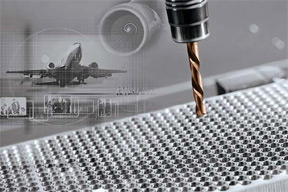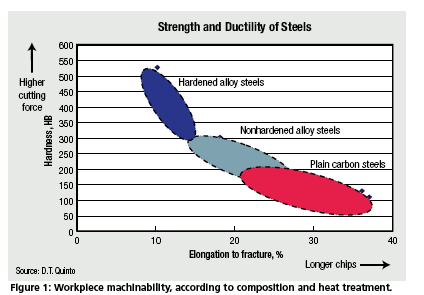

Coating Choice
The specific fracture energy is proportional to the product of fracture stress times the fracture strain; this is known as the plastic deformation energy that is converted to heat during chip formation. The second source of heat is friction generated as the chip rubs on the tool’s rake face. The higher the workpiece’s ductility, the higher its contact length with the tool rake, which produces more frictional heat. A plot of the envelopes of hardness and ductility properties of the steels along with different workpiece materials is shown in Figure 2. Machinability improves with short-chipping metals but declines as longer chips are generated (due to ductility) and higher cutting forces are needed (due to strength or hardness). Other metallurgical factors affecting machinability and tool life—second phases, inclusions, strain hardening—are also indicated.
Easily machinable workpieces can be machined at high
cutting Hard coatings for cutting tools combat the high stress and temperatures imposed on the cutting edge during chip formation. The tool life difference between uncoated and coated tools today can vary by a factor of two to 10, depending on the application. A snapshot of proven successful coatings in cutting the various workpiece materials discussed previously is also provided in Figure 2. Coatings are matched to workpiece chip formation characteristics and cutting conditions. The early generation of PVD TiN and TiCN coatings is still effective at normal machining conditions for carbon and alloy steels, but as speed is increased, TiAlN-type coatings become more suitable because they have enhanced stability at higher temperatures. Difficult-to-machine aerospace alloys demand cutting tools with optimal cutting edge design, including controlled microgeometry—the parameters defining cutting edge sharpness, such as an edge chamfer or edge hone radius. The hone may be fixed or variable along the length of the cutting edge. These microscopic features— hone radius is typically 0.001"—lower stress concentrations at the cutting edge, which is further protected by the PVD coating. Materials scientists have altered the compositions of new PVD coatings— such as adding Si to TiN to form TiSiN, increasing levels of Al in AlTiN or substituting Cr for Ti in AlCrN—to form nanostructures that yield high hardness, plasticity and oxidation resistance at the high temperatures generated when cutting difficult-to-machine materials. The coatings enable higher speeds and increased tool life while keeping other cutting conditions the same as with uncoated tools. Several studies have postulated various mechanisms of improvement for different cutting applications, e.g. better abrasive wear resistance, microcrack suppression, lowered contact friction, formation of stabilizing AlCr oxide surface films or improved heat barriers due to hard coatings. Milling Titanium For example, the new midsize Boeing 787 Dreamliner, with deliveries due to begin in 2008, is expected to consume 20 percent less fuel than traditional midsize jets by using lightweight, high-strength-to-weight-ratio materials. About half of the 787’s primary structure is made from composite materials and another 15 percent from titanium. In addition to being lighter than aluminum, both titanium and composite materials resist corrosion and require less maintenance than aluminum. Titanium is also more compatible with composites than aluminum, which produces corrosive galvanic reactions with carbon fibers in the composite structure. Titanium, however, poses several machining challenges. It generally requires slow cutting speeds and low feed rates and requires radial DOCs on the order of 100 percent and axial DOCs on the order of 30 percent to avoid heat build-up. As a result, machining titanium can cost 10 times more than machining aluminum. A new grade of titanium, Ti-5553 (Ti-5Al-5V-5Mo-3Cr) is now preferred for key components over Ti-6Al-4V because it exhibits excellent hardenability and has high cycle fatigue behavior properties. Unfortunately, it is even more difficult to machine than traditional titanium alloys. Several cutting tool manufacturers are working on this problem. One of those companies, Niagara Cutter Inc., Amherst, N.Y., is working with aerospace companies to develop optimal tooling and operating parameters to machine Ti-5553. Testing is underway at NCI’s Reynoldsville, Pa., laboratory and in the field to explore the role of tool geometries, edge preparation techniques and the use of coatings to act as a heat barrier in solving these machining challenges. The company has developed guidelines for rough, semifinish and finish milling of Ti-5553. NCI recommends an M-42 cobalt-HSS or P/M cobalt- HSS fine-pitch roughing endmill with a TiCN or TiAlN coating and a cutting speed from 40 to 60 sfm at a feed rate of 3 to 5 ipm. For semifinish milling, a 4-flute solid-carbide endmill with a TiAlN coating, a 70- to 100-sfm speed and 5- to 7-ipm feed is recommended, and for finish milling, a 6- to 8-flute solid-carbide endmill with a TiAlN coating, operating at 400 sfm and 5 to 7 ipm. Sherwood Bollier, president of NCI, said a new tool geometry that NCI refers to as a variable-face profile, in combination with coatings and proper operating parameters, yields improved chip flow characteristics and eliminates problems associated with chip packing, also known as a bird’s nest.
According to Roger Bollier, president of Diamond Tool Coating, North Tonawanda, N.Y., CVD PCD coatings are the best choice for machining many composites. DTC supplied coatings for development work by the National Center for Defense Manufacturing and Machining, Latrobe, Pa., for Lockheed Martin Aeronautics, which machines advanced composite wing-skin material for the F-35 Lightning II stealth fighter. Initial machining of the wing-skin material produced short tool life and excessive delamination. The use of 20µm-thick CVD PCD coatings, in combination with optimized tool geometry, increased tool life more than six times and reduced the workpiece delamination problem. Machining performance improvements have always relied on the synergies in designing tool materials, cutting edge geometries and coatings. In recent years, PVD coating developments in particular have lowered the traditional barriers to metalcutting productivity in the so-called difficultto- machine aerospace materials. About the Authors | |||

| |
Diamond
Tool Coating 661 Erie Avenue North Tonawanda, NY 14120 |
 |
| ©
2013 Diamond Tool Coating |

 The
continuous development of new workpiece materials aimed at making
products lighter yet stronger often pose machining problems. Ongoing
development work in chemical vapor deposition and physical vapor
deposition wear-resistant thin-film coatings—driven by the
need to continuously improve productivity— is directed at
these new machining applications. This article examines tool coating
options and strategies for difficult applications, such as milling
new grades of titanium and machining composites for aerospace parts.
The
continuous development of new workpiece materials aimed at making
products lighter yet stronger often pose machining problems. Ongoing
development work in chemical vapor deposition and physical vapor
deposition wear-resistant thin-film coatings—driven by the
need to continuously improve productivity— is directed at
these new machining applications. This article examines tool coating
options and strategies for difficult applications, such as milling
new grades of titanium and machining composites for aerospace parts.


 Cutting
Composites
Cutting
Composites